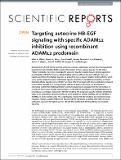Targeting autocrine HB-EGF signaling with specific ADAM12 inhibition using recombinant ADAM12 prodomain
Author(s)
Miller, Miles Aaron; Moss, Marcia L.; Powell, Gary; Petrovich, Robert; Edwards, Lori; Griffith, Linda G.; Lauffenburger, Douglas A.; Meyer, Aaron Samuel; ... Show more Show less
DownloadMiller_Targeting autocrine.pdf (1.057Mb)
PUBLISHER_CC
Publisher with Creative Commons License
Creative Commons Attribution
Terms of use
Metadata
Show full item recordAbstract
Dysregulation of ErbB-family signaling underlies numerous pathologies and has been therapeutically targeted through inhibiting ErbB-receptors themselves or their cognate ligands. For the latter, “decoy” antibodies have been developed to sequester ligands including heparin-binding epidermal growth factor (HB-EGF); however, demonstrating sufficient efficacy has been difficult. Here, we hypothesized that this strategy depends on properties such as ligand-receptor binding affinity, which varies widely across the known ErbB-family ligands. Guided by computational modeling, we found that high-affinity ligands such as HB-EGF are more difficult to target with decoy antibodies compared to low-affinity ligands such as amphiregulin (AREG). To address this issue, we developed an alternative method for inhibiting HB-EGF activity by targeting its cleavage from the cell surface. In a model of the invasive disease endometriosis, we identified A Disintegrin and Metalloproteinase 12 (ADAM12) as a protease implicated in HB-EGF shedding. We designed a specific inhibitor of ADAM12 based on its recombinant prodomain (PA12), which selectively inhibits ADAM12 but not ADAM10 or ADAM17. In endometriotic cells, PA12 significantly reduced HB-EGF shedding and resultant cellular migration. Overall, specific inhibition of ligand shedding represents a possible alternative to decoy antibodies, especially for ligands such as HB-EGF that exhibit high binding affinity and localized signaling.
Date issued
2015-10Department
Massachusetts Institute of Technology. Department of Biological Engineering; Koch Institute for Integrative Cancer Research at MITJournal
Scientific Reports
Publisher
Nature Publishing Group
Citation
Miller, Miles A., Marcia L. Moss, Gary Powell, Robert Petrovich, Lori Edwards, Aaron S. Meyer, Linda G. Griffith, and Douglas A. Lauffenburger. “Targeting Autocrine HB-EGF Signaling with Specific ADAM12 Inhibition Using Recombinant ADAM12 Prodomain.” Scientific Reports 5 (October 19, 2015): 15150.
Version: Final published version
ISSN
2045-2322